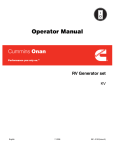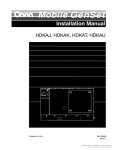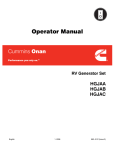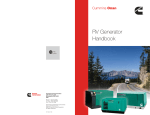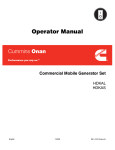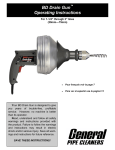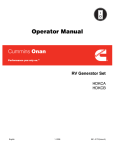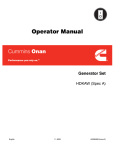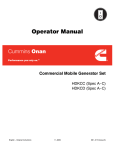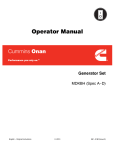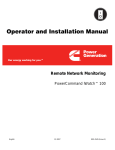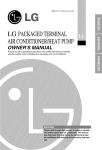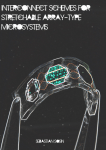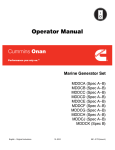Download Operator Manual - Electric Generators Direct
Transcript
Operator Manual RV Generator Set HDKAH (Spec A−M) HDKAJ (Spec A−M) HDKAK (Spec A−M) HDKAT (Spec A−M) HDKAU (Spec A−M) HDKAV (Spec A−M) English − Original Instructions 5−2010 981−0161 (Issue 7) California Proposition 65 Warning Diesel engine exhaust and some of its constituents are known to the State of California to cause cancer, birth defects, and other reproductive harm. diesel warnings Table of Contents SAFETY PRECAUTIONS . . . . . . . . . . . . . . . . . . . . . . . . . . . . . . . . . . . . . . . . . . . . . . . . . . . INTRODUCTION . . . . . . . . . . . . . . . . . . . . . . . . . . . . . . . . . . . . . . . . . . . . . . . . . . . . . . . . . . . About This Manual . . . . . . . . . . . . . . . . . . . . . . . . . . . . . . . . . . . . . . . . . . . . . . . . . . . . . . Model Identification . . . . . . . . . . . . . . . . . . . . . . . . . . . . . . . . . . . . . . . . . . . . . . . . . . . . . Typical Genset . . . . . . . . . . . . . . . . . . . . . . . . . . . . . . . . . . . . . . . . . . . . . . . . . . . . . . . . . Fuel Recommendations . . . . . . . . . . . . . . . . . . . . . . . . . . . . . . . . . . . . . . . . . . . . . . . . . Engine Oil Recommendations . . . . . . . . . . . . . . . . . . . . . . . . . . . . . . . . . . . . . . . . . . . . Starting Batteries . . . . . . . . . . . . . . . . . . . . . . . . . . . . . . . . . . . . . . . . . . . . . . . . . . . . . . . Operator’s Console . . . . . . . . . . . . . . . . . . . . . . . . . . . . . . . . . . . . . . . . . . . . . . . . . . . . . Remote Control Panel . . . . . . . . . . . . . . . . . . . . . . . . . . . . . . . . . . . . . . . . . . . . . . . . . . . OPERATION . . . . . . . . . . . . . . . . . . . . . . . . . . . . . . . . . . . . . . . . . . . . . . . . . . . . . . . . . . . . . . . Conducting the Pre-Start Checks . . . . . . . . . . . . . . . . . . . . . . . . . . . . . . . . . . . . . . . . . priming the Fuel System . . . . . . . . . . . . . . . . . . . . . . . . . . . . . . . . . . . . . . . . . . . . . . . . . Starting the Genset . . . . . . . . . . . . . . . . . . . . . . . . . . . . . . . . . . . . . . . . . . . . . . . . . . . . . Stopping the Genset . . . . . . . . . . . . . . . . . . . . . . . . . . . . . . . . . . . . . . . . . . . . . . . . . . . . Restarting the Genset . . . . . . . . . . . . . . . . . . . . . . . . . . . . . . . . . . . . . . . . . . . . . . . . . . . Loading the Genset . . . . . . . . . . . . . . . . . . . . . . . . . . . . . . . . . . . . . . . . . . . . . . . . . . . . . Resetting Circuit Breakers . . . . . . . . . . . . . . . . . . . . . . . . . . . . . . . . . . . . . . . . . . . . . . . Connecting to Utility Power . . . . . . . . . . . . . . . . . . . . . . . . . . . . . . . . . . . . . . . . . . . . . . Operating in Cold Weather . . . . . . . . . . . . . . . . . . . . . . . . . . . . . . . . . . . . . . . . . . . . . . . Operating in Hot Weather . . . . . . . . . . . . . . . . . . . . . . . . . . . . . . . . . . . . . . . . . . . . . . . . Operating at High Altitude . . . . . . . . . . . . . . . . . . . . . . . . . . . . . . . . . . . . . . . . . . . . . . . Operating in Dusty Environments . . . . . . . . . . . . . . . . . . . . . . . . . . . . . . . . . . . . . . . . . Breaking in a New Engine . . . . . . . . . . . . . . . . . . . . . . . . . . . . . . . . . . . . . . . . . . . . . . . Exercising the Genset . . . . . . . . . . . . . . . . . . . . . . . . . . . . . . . . . . . . . . . . . . . . . . . . . . . Storing the Genset . . . . . . . . . . . . . . . . . . . . . . . . . . . . . . . . . . . . . . . . . . . . . . . . . . . . . . PERIODIC MAINTENANCE . . . . . . . . . . . . . . . . . . . . . . . . . . . . . . . . . . . . . . . . . . . . . . . . . Conducting General Inspections . . . . . . . . . . . . . . . . . . . . . . . . . . . . . . . . . . . . . . . . . . Checking Engine Oil Level . . . . . . . . . . . . . . . . . . . . . . . . . . . . . . . . . . . . . . . . . . . . . . . Changing Engine Oil and Oil Filter . . . . . . . . . . . . . . . . . . . . . . . . . . . . . . . . . . . . . . . . Maintaining the Battery and Battery Connections . . . . . . . . . . . . . . . . . . . . . . . . . . . Replacing the Air Filter Element . . . . . . . . . . . . . . . . . . . . . . . . . . . . . . . . . . . . . . . . . . Cleaning the Spark Arrestor . . . . . . . . . . . . . . . . . . . . . . . . . . . . . . . . . . . . . . . . . . . . . . Replacing the Fuel Filter . . . . . . . . . . . . . . . . . . . . . . . . . . . . . . . . . . . . . . . . . . . . . . . . . Changing Coolant . . . . . . . . . . . . . . . . . . . . . . . . . . . . . . . . . . . . . . . . . . . . . . . . . . . . . . TROUBLESHOOTING . . . . . . . . . . . . . . . . . . . . . . . . . . . . . . . . . . . . . . . . . . . . . . . . . . . . . . SPECIFICATIONS . . . . . . . . . . . . . . . . . . . . . . . . . . . . . . . . . . . . . . . . . . . . . . . . . . . . . . . . . . INFORMATION FOR CALIFORNIA GENSET USERS . . . . . . . . . . . . . . . . . . . . . . . . . . . HOW TO OBTAIN SERVICE . . . . . . . . . . . . . . . . . . . . . . . . . . . . . . . . . . . . . . . . . . . . . . . . . MAINTENANCE RECORD . . . . . . . . . . . . . . . . . . . . . . . . . . . . . . . . . . . . . . . . . . . . . . . . . . . i 2 4 4 4 5 6 6 6 7 7 8 8 8 8 9 9 9 10 10 11 11 11 11 11 11 12 13 14 15 16 17 17 18 19 20 22 31 33 34 35 Safety Precautions • Do not operate the genset when the vehicle is in a confined space, such as a garage. Thoroughly read the OPERATOR’S MANUAL before operating the genset. Safe operation and top performance can only be obtained when equipment is operated and maintained properly. • Disable the automatic genset starting feature of an inverter-charger or other automatic starting device before storing the vehicle or parking it in a garage or other confined space. The following symbols in this manual alert you to potential hazards to the operator, service person and equipment. • The exhaust system must be installed in accordance with the genset Installation Manual. alerts you to an immediate hazard that will result in severe personal injury or death. • Engine cooling air must not be used for heating working or living spaces or compartments. alerts you to a hazard or unsafe practice that can result in severe personal injury or death. • Disable the automatic genset starting feature(AGS) of an inverter−charger or other automatic starting device before servicing the genset to avoid electric shock from an unexpected start. GENERATOR VOLTAGE IS DEADLY WARNING alerts you to a hazard or unsafe practice that can result in personal injury or equipment damage. CAUTION • Generator electrical output connections must be made by a trained and experienced electrician in accordance with applicable codes. When equipped with an integral or add−on Auto− matic Generator Starting System (AGS) control,exhaust carbon monoxide (CO), electric shock, andmoving parts hazards are possible due to unex− pected starting. Turn off AGS whenever performingmaintenance or service, when the vehicle is storedbetween uses, is awaiting service, or is parked in agarage or other confined area. • The genset must not be connected to the public utility or any other source of electrical power. Back-feed could lead to electrocution of utility personnel and damage to equipment. An approved switching device must be used to prevent interconnections. • Use caution when working on live electrical equipment. Remove jewelry, make sure clothing and shoes are dry, stand on a dry wooden platform or rubber insulating mat and use tools with insulated handles. Electricity, fuel, exhaust, moving parts and batteries present hazards which can result in severe personal injury or death. DIESEL FUEL IS COMBUSTIBLE ENGINE EXHAUST IS DEADLY • Do not smoke or turn electrical switches ON or OFF where fuel fumes are present or in areas sharing ventilation with fuel tanks or equipment. Keep flames, sparks, pilot lights, arc-producing equipment and all other sources of ignition well away. • Inspect for exhaust leaks at every startup and after every eight hours of running. • Learn the symptoms of carbon monoxide poisoning in the Operator’s Manual. • Never sleep in the vehicle while the genset is running unless the vehicle is equipped with a working carbon monoxide detector. • Fuel lines must be secured, free of leaks and separated or shielded from electrical wiring. 1 MOVING PARTS CAN CAUSE SEVERE PERSONAL INJURY OR DEATH • Let the engine cool down before removing the coolant pressure cap or opening the coolant drain. Hot coolant under pressure can spray out and cause severe burns. • Disable the automatic genset starting feature(AGS) of an inverter−charger or other automatic starting device before servicing the genset to avoid unexpected starting. • Keep the genset and its compartment clean. Excess oil and oily rags can catch fire. Dirt and gear stowed in the compartment can restrict cooling air. • Do not wear loose clothing or jewelry near moving parts such as PTO shafts, fans, belts and pulleys. • Make sure all fasteners are secure and torqued properly. • Keep hands away from moving parts. • Do not work on the genset when mentally or physically fatigued or after consuming alcohol or drugs. BATTERY GAS IS EXPLOSIVE • Wear safety glasses. • Do not smoke. • You must be trained and experienced to make adjustments while the genset is running—hot, moving or electrically live parts can cause severe personal injury or death. • To reduce arcing when disconnecting or reconnecting battery cables, always disconnect the negative (−) battery cable first and reconnect it last. • Used engine oil has been identified by some U. S. state and federal agencies as causing cancer or reproductive toxicity. Do not ingest, inhale, or contact used oil or its vapors. FLAMMABLE VAPOR CAN CAUSE A DIESEL ENGINE TO OVERSPEED Flammable vapor can cause a diesel engine to overspeed and become difficult to stop, resulting in possible fire, explosion, severe personal injury and death. Do not operate a diesel-powered genset where a flammable vapor environment can be created by fuel spill, leak, etc. The owners and operators of the genset are solely responsible for operating the genset safely. • Ethylene glycol, used as engine antifreeze, is toxic to humans and animals. Clean up spills and dispose of used engine coolant in accordance with local environmental regulations. • Keep multi-class ABC fire extinguishers handy. Class A fires involve ordinary combustible materials such as wood and cloth; Class B fires, combustible and flammable liquid fuels and gaseous fuels; Class C fires, live electrical equipment. (ref. NFPA No. 10) GENERAL PRECAUTIONS • Keep children away from the genset. • Genset installation and operation must comply with all applicable local, state and federal codes and regulations. • Do not use evaporative starting fluids. They are highly explosive. • To prevent accidental or remote starting while working on the genset, disconnect the negative (−) battery cable at the battery. • Keep guards in place over fans, belts, pulleys, and other moving parts. Mobile-8 2 Introduction ABOUT THIS MANUAL This manual covers the operation and maintenance of the generator set (genset) models on the front cover. Study this manual carefully and observe all of its instructions and precautions. Keep this manual and the genset Installation Manual with the other vehicle manuals. 80HDKAK11454J F990 123456 Operation, Periodic Maintenance and Troubleshooting provide the instructions necessary for operating the genset and maintaining it at top performance. The owner is responsible for performing maintenance in accordance with the PERIODIC MAINTENANCE SCHEDULE (Page 12). This manual also includes genset specifications, information on how to obtain service and information for California users. SKB719U6D2RA 719 cc WARNING This genset is not a life support system. It can stop without warning. Children, persons with physical or mental limitations, and pets could suffer personal injury or death. A personal attendant, redundant power or an alarm system must be used if genset operation is critical. MODEL IDENTIFICATION RECORD NUMBERS HERE When contacting an Onan dealer for parts, service or product information, be ready to provide the model and serial numbers on the genset nameplate. Figure 1 illustrates the nameplate and its location. The numbers in the gray boxes are typical model and serial numbers. Every character in these numbers is significant. (The last character of the model number is the specification letter, which is important for obtaining the right parts.) Record the model and serial numbers in the boxes in Figure 1 so that they are easy to find when you need them. MODEL NUMBER: SERIAL NUMBER: FIGURE 1. TYPICAL NAMEPLATE 3 TYPICAL GENSET features of a typical genset are shown in Figure 2. See the PERIODIC MAINTENANCE SCHEDULE (Page 12). The operator’s console, the components requiring attention during periodic maintenance and other AC TERMINAL BOX COVER LIFTING EYE ACCESS COVER OPERATOR’S CONSOLE ACCESS DOOR FOR OIL AND FUEL FILTERS OIL DRAIN PLUG BATTERY CONNECTIONS COOLING AIR INLET GRILLE ACCESS TO AIR FILTER FUEL CONNECTIONS COOLANT DRAIN CAP WARM AIR DISCHARGE OPENING FIGURE 2. TYPICAL GENSET 4 EXHAUST TAILPIPE FLANGE (NOT VISIBLE) FUEL RECOMMENDATIONS SAE (Society of Automotive Engineers) viscosity grade. Referring to Chart 1, choose the viscosity grade appropriate for the outdoor ambient temperatures expected until the next scheduled oil change. WARNING Diesel fuel is combustible and can cause severe personal injury or death. Do not smoke near diesel fuel tanks or equipment. Keep flames, sparks, pilot lights, electrical arcs, switches and arc-producing equipment and all other sources of ignition well away. Keep a type ABC fire extinguisher in the vehicle. STARTING BATTERIES These gensets have a 12 volt, direct current (DC) starting and control system. See Specifications (Page 30) for minimum battery requirements (cold cranking amperes) for genset starting. Use clean, fresh No. 2 diesel fuel (ASTM 2-D) when the outdoor ambient temperature is above freezing, and No. 1 diesel fuel (ASTM 1-D) when below freezing. The fuel should have a Cetane number of at least 45 for reliable starting. Regular, monthly maintenance of batteries may be required. See MAINTAINING THE BATTERY AND BATTERY CONNECTIONS (Page 16) and any instructions available from the vehicle manufacturer or battery manufacturer. Either the vehicle or the genset will be equipped with a battery charger. ENGINE OIL RECOMMENDATIONS Use API (American Petroleum Institute) performance Class CH-4, CG-4 or CF-4 engine oil, which may be in combination with performance Class SJ, SH or SG (for example: CH-4/SJ). Also look for the Reliable genset starting and starter service life depend upon adequate battery system capacity and proper maintenance. CHART 1. OIL VISCOSITY VS. TEMPERATURE Anticipated Ambient Temperature 5 OPERATOR’S CONSOLE REMOTE CONTROL PANEL The operator’s console (Figure 3) has the following features: The vehicle may be equipped with a remote control panel having a Control Switch and Preheat/Diagnostics Light. In addition, it may have an hour meter and the following engine gauges: Control Switch − This switch is used to start and stop the genset, prime the engine fuel system and restore the fault code (blinking status light). Oil Pressure Gauge − The oil pressure gauge indicates the presence of engine oil pressure. Status Light − This is an LED (light emitting diode) in the control switch which blinks rapidly during preheat and cranking. (Preheat is the period of time prior to engine cranking when the glow plugs preheat the combustion chambers. The time is automatically varied by the genset controller on the basis of engine temperature.) After the genset starts up, this light stays on continuously, indicating that the genset is running and that the starter has disconnected. Also, if the genset shuts down, this light blinks in a coded fashion to indicate the nature of the shutdown (see Troubleshooting, Page 21). Water Temperature Gauge − The water temperature gauge indicates engine coolant temperature. Voltmeter − The voltmeter indicates battery voltage. ACCESS PLATE COOLANT RECOVERY TANK FILL CAP (BLUE) OIL FILL CAP AND DIP STICK (YELLOW) Line Circuit Breaker(s) − The line circuit breaker(s) protect the AC power leads connected to the genset. Engine Oil Fill Cap/Dipstick − The oil dipstick is attached to the fill cap and is marked ADD and FULL. Coolant Recovery Tank Fill Cap − The recovery tank provides for coolant expansion. Replenish the normal loss of coolant by filling here. Coolant Pressure Cap − The coolant pressure cap is accessible by removing the access plate on the control console. It provides for a pressurized engine cooling system. Fill coolant here when refilling the system. Fuses F1, F2 and F3 − These fuses are accessible by removing the access plate on the control console. They protect the control circuits of the genset. CONTROL SWITCH AND STATUS LIGHT Hour Meter (Optional)− The hour meter records the total running time of the genset. It cannot be reset. HOUR METER (OPTIONAL) LINE CIRCUIT BREAKER FIGURE 3. OPERATOR’S CONSOLE 6 Operation WARNING EXHAUST GAS IS DEADLY! Exhaust gases contain carbon monoxide, an odorless, colorless gas. Carbon monoxide is poisonous and can cause unconsciousness and death. Symptoms of carbon monoxide poisoning include: • • • Dizziness Muscular Twitching Weakness and Sleepiness • • • Throbbing in Temples Headache Inability to Think Clearly • • Nausea Vomiting IF YOU OR ANYONE ELSE EXPERIENCES ANY OF THESE SYMPTOMS, GET OUT INTO THE FRESH AIR IMMEDIATELY. If symptoms persist, seek medical attention. Shut down the genset and do not operate it until it has been inspected and repaired. Never sleep in the vehicle with the genset running unless the vehicle is equipped with a working carbon monoxide detector. Primary protection against poisoning due to inhaling carbon monoxide, however, consists of proper installation of the exhaust system and inspections every day (every eight hours of operation) for visible and audible exhaust system leaks. CONDUCTING THE PRE-START CHECKS 1. Push and hold the switch at START until the genset starts. The status indicator light on the switch flashes during preheat and cranking. It will come on solid when the starter disconnects, indicating that the genset is running. (Depending on how cold it is, preheat can take up to 15 seconds, extending the time that the light blinks.) Before the first start of the day and after every eight hours of operation, inspect the genset as instructed under CONDUCTING GENERAL INSPECTIONS (Page 13). Keep a log of maintenance and the hours run and perform any maintenance that may be due. See Returning the Genset to Service (Page 11) if the vehicle has been in storage. CAUTION Excessive cranking can overheat and damage the starter motor. Do not crank for more than 20 seconds at a time. Wait at least 2 minutes before trying again. Before each start: 1. Make sure all vehicle CO detectors are working. 2. See Troubleshooting (Page 21) if the genset does not start after three tries. 2. Check for signs of fuel and exhaust leaks and for damage to the exhaust system. 3. For top performance and engine life, especially in colder weather, let the engine warm up for two minutes before connecting appliances. 3. Turn off the air conditioner and other large appliances. 4. Monitor the engine gauges if the remote panel is so equipped. Normal readings during operation are as follows: PRIMING THE FUEL SYSTEM The fuel system should be primed after replacing the fuel filter or running the genset out of fuel. To prime the fuel system hold the control switch down in its Stop position for at least 1 minute. Oil Pressure: Approximate center of scale Temperature: 160°-220° F (71°-104° C) DC Voltage: 14-15 volts. STARTING THE GENSET 5. Check for fuel, exhaust and coolant leaks. Stop the genset immediately if there is a fuel, exhaust or coolant leak and have it repaired. Start the genset from the genset control panel or remote control panel inside the vehicle. 7 STOPPING THE GENSET TABLE 1. TYPICAL APPLIANCE LOADS Appliance Air Conditioner Battery Charger DC Converter Refrigerator Microwave Oven Electric Frying Pan or Wok Electric Stove Element Electric Water Heater Electric Iron Electric Hair Dryer Coffee Percolator Television Radio Electric Drill Electric Broom Electric Blanket Turn off the air conditioner and other large appliances and let the genset run for two minutes to cool down. Then press the switch to STOP to stop the genset. RESTARTING THE GENSET See Troubleshooting (Page 21) if the genset shuts down abnormally. LOADING THE GENSET The genset can power AC motors, air conditioners, AC/DC converters, battery chargers and other appliances. How much appliance load* can be powered depends upon the genset power rating. The genset will shut down or its circuit breakers will trip if the sum of the loads exceeds genset power. (If the genset shuts down, the status light will probably display Fault Code No. 11, 13, 22 or 38. See Troubleshooting, Page 21.) Load (watts) 1400-2000 Up to 2000 300-1200 600-1000 1000-1500 1000-1500 350-1000 1000-1500 500-1200 800-1500 550-750 200-600 50-200 250-750 200-500 50-200 TABLE 2. POWER VS. ALTITUDE To avoid overloading the genset and causing shutdowns, compare the sum of the loads of the appliances that are likely to be used at the same time to the power rating of the genset. Use Table 1 or the ratings on the appliances themselves (if so marked) to obtain the individual appliance loads. It may be necessary to run fewer appliances at the same time—the sum of the loads must not be greater than genset rating. Elevation above Mean Sea Level up to 500 ft (152 m) The genset may shut down due to overload when a large motor or air conditioner is started or cycles off and then on again, even though the sum of the loads is less than genset rating. The reason for this is that a motor’s startup load is much larger than its running load. It may be necessary to run fewer appliances when large motors and air conditioners are cycling on and off. Max Genset Power* Max Genset Power* 7500 watts (rated) 8000 watts (rated) 2500 ft (762 m) 7050 watts 7520 watts 5500 ft (1676 m) 6375watts 6800watts 6375watts minus 6800watts minus 225 watts ev240 watts every1000 ft ery1000 ft (305 m) (305 m) * This table does not take into account the effect circuit breakers may have in limiting maximum power. above 5500 ft (1676 m) Commercial Genset Applications Maximum power decreases as altitude increases because air density decreases. For every 1000-foot (305 m) increase in elevation you can expect power to decrease approximately 3 percent. Table 2 shows the results of typical calculations. It may be necessary to run fewer appliances at higher altitudes. Maximum genset power (nameplate rating) is 7500 watts in an ambient of 85° F (29° C), but only 6000 watts in an ambient of 120° F (50° C)—the maximum operating temperature. Also, continuous operation at up to 80 percent of maximum power (6000 watts) is acceptable. * Appliance load and genset power are measured in terms of watts (W) or kilowatts (kW), where 1 kilowatt (kW) = 1000 watts (W). 8 RESETTING CIRCUIT BREAKERS If a circuit breaker in the main power distribution panel of the vehicle or on the genset (Figure 4) trips, either a circuit shorted or too many appliances were running. Note that the genset will continue to run after a circuit breaker trips. If a circuit breaker trips, disconnect or turn off as many loads as possible and reset the circuit breaker. (Push the circuit breaker to OFF to reset it and then to ON to reconnect the circuit.) If the circuit breaker trips right away, either the electrical distribution system has a short or the circuit breaker is faulty. Call a qualified electrician. If the circuit breaker does not trip, reconnect the appliances, one by one, up to a total load that does not overload the genset or cause the circuit breaker to trip. If a circuit breaker trips right away when an appliance is connected, the appliance probably has a short. LINE CIRCUIT BREAKER Electrical appliances and tools must be used and maintained properly and be properly grounded to cause the line circuit breakers to trip when short circuits occur. FIGURE 4. LINE CIRCUIT BREAKER WARNING Short circuits in electrical appliances and tools can cause fire and electrical shock leading to severe personal injury or death. Read and follow the equipment and tool manufacturer’s instructions and warnings regarding use, maintenance and proper grounding. CONNECTING TO UTILITY POWER When the vehicle has provisions for connecting to utility power, such as a cord for plugging into a power outlet receptacle, it must also have an approved device to keep the genset and utility from being interconnected. See the genset Installation Manual for more information. WARNING Interconnecting the genset and the public utility (or any other power source) can lead to the electrocution of personnel working on the utility lines, damage to equipment and fire. An approved switching device must be used to prevent interconnections. 9 OPERATING IN COLD WEATHER 3. Change engine oil more often. See PERIODIC MAINTENANCE SCHEDULE (Page 12). Make sure the engine oil viscosity is appropriate for the cold weather temperatures. See ENGINE OIL RECOMMENDATIONS (Page 5). Be sure to change the oil if a sudden drop in temperature occurs. 4. Keep containers of engine oil that have been opened tightly closed to keep out dust. BREAKING IN A NEW ENGINE Proper engine break-in on a new genset or on one with a rebuilt engine is essential for top engine performance and acceptable oil consumption. Run the genset at approximately 1/2 rated power for the first 2 hours and then at 3/4 rated power for 2 more hours. See LOADING THE GENSET (Page 8). OPERATING IN HOT WEATHER Pay particular attention to the following items when operating the genset in hot weather: 1. Make sure nothing blocks airflow to and from the genset. Proper engine oil and oil level are especially critical during break-in because of the higher engine temperatures that can be expected. Change the oil if not appropriate for the ambient temperatures during break-in. See ENGINE OIL RECOMMENDATIONS (Page 5). Check oil level twice a day or every 4 hours during the first 24 hours of operation and change the oil and oil filter after the first 50 hours of operation. 2. Make sure engine oil viscosity is appropriate for the ambient temperatures. See ENGINE OIL RECOMMENDATIONS (Page 5). 3. Keep the genset clean. 4. Perform maintenance due. See PERIODIC MAINTENANCE SCHEDULE (Page 12). OPERATING AT HIGH ALTITUDE EXERCISING THE GENSET For the effect of altitude on maximum power, see LOADING THE GENSET (Page 8). Exercise the genset at least 2 hours each month if use is infrequent. Run the genset at approximately 1/2 rated power. See LOADING THE GENSET (Page 8). A single two hour exercise period is better than several shorter periods. OPERATING IN DUSTY ENVIRONMENTS Pay particular attention to the following items when operating the genset in dusty environments: 1. Do not let dirt and debris accumulate inside the genset compartment. Keep the genset clean. Exercising a genset drives off moisture, re-lubricates the engine, replaces stale fuel and removes oxides from electrical contacts. The result is better starting, more reliable operation and longer engine life. 2. Perform air cleaner maintenance more often. See PERIODIC MAINTENANCE SCHEDULE (Page 12). 10 STORING THE GENSET 5. Close the fuel supply valve (if so equipped). Proper storage is essential for preserving top genset performance and reliability when the genset cannot be exercised regularly and will be idle for more than 120 days. Returning the Genset to Service 1. Check the oil tag on the genset and change the oil if the viscosity indicated is not appropriate for the temperatures expected. See ENGINE OIL RECOMMENDATIONS (Page 5). Storing the Genset 2. Reconnect the starting battery (negative [−] cable last). See MAINTAINING THE BATTERY AND BATTERY CONNECTIONS (Page 16). 1. Push the genset line circuit breaker OFF (Page 9). 2. Change the engine oil and attach a tag indicating oil viscosity. See ENGINE OIL RECOMMENDATIONS (Page 5). 3. Remove the plug from the exhaust tailpipe. 4. Change the air filter element if it is dirty (Page 16). 3. Disconnect the battery cables (negative [−] cable first) from the starting battery and store the battery according to the battery manufacturer’s recommendations. See MAINTAINING THE BATTERY AND BATTERY CONNECTIONS (Page 16). 5. Open the fuel supply valve (if so equipped). 6. Inspect the genset. See CONDUCTING GENERAL INSPECTIONS (Page 13). 7. Push the genset line circuit breaker ON (Page 9) when the genset is ready to power appliances. 4. Plug the exhaust tail pipe to keep out dirt, moisture, bugs, etc. 11 Periodic Maintenance Periodic maintenance is essential for top performance and long genset life. Use Table 3 as a guide for normal periodic maintenance. In hot and dusty environments some maintenance procedures should be performed more frequently, as indicated by the footnotes in the table. Keeping a log of maintenance performed and hours run (Page 34) will help you keep genset maintenance regular and provide a basis for supporting warranty claims. Maintenance, replacement or repair of emission control devices and systems may be performed by any engine repair establishment or individual. However, warranty work must be completed by an authorized Onan dealer. TABLE 3. PERIODIC MAINTENANCE SCHEDULE MAINTENANCE FREQUENCY MAINTENANCE PROCEDURE Every Day After First 50 Hours Every Month Every 150 Hours Every 500 Hours Every 1000 Hours P a g e General Inspection X 13 Check Engine Oil Level X 14 Check Engine Coolant Level X 19 X3 Clean and Check Battery X1 Change Engine Oil and Filter 16 X2, 3, 4 15 X4 17 Clean Spark Arrestor X2, 4 16 Replace Fuel Filter X 18 Check Coolant Anti-freeze Protection X 19 Replace Engine Air Filter Flush Coolant System X5 19 Replace Coolant Pressure Cap X5 19 Replace Engine V-belt X6,7 − Clean Crankcase Breather X6,7 − Replace Coolant Hoses and Thermostat X6, 7 − 1 − As a part of engine break-in, change the engine oil after the first 50 hours of operation. 2 − Perform more often when operating in dusty conditions. 3 − Perform more often when operating in hot weather. 4 − Perform at least once a year. 5 − Perform at least once every two years. 6 − Perform at least once every five years. 7 − Must be performed by a qualified mechanic (authorized Onan dealer). 12 CONDUCTING GENERAL INSPECTIONS Inspect the genset before the first start of the day and after every eight hours of operation. Do not operate power ventilators or exhaust fans while the vehicle is standing with the genset running. The ventilator or fan can draw exhaust gases into the vehicle. Oil Level Fuel System Check engine oil level (Page 14). Check for leaks at hose, tube and pipe fittings in the fuel supply system while the genset is running and while it is stopped. Check flexible fuel hose sections for cuts, cracks, and abrasions. Make sure the fuel line is not rubbing against other parts. Replace worn or damaged fuel line parts before leaks occur. Engine Coolant System Operating the genset when coolant level is low can cause serious engine damage. CAUTION Check the coolant level and look for coolant leaks around the bottom of the genset and on the ground below. Minor leaks that can be replenished by daily additions of coolant to the recovery tank should be repaired by a qualified service technician as soon as possible. Larger leaks are cause for shutting down the genset until it can be repaired. WARNING Diesel fuel leaks can lead to fire. Do not operate the genset if operation causes fuel to leak. Battery Connections Check the battery terminals for clean, tight connections. Loose or corroded connections have high electrical resistance which makes starting harder. See MAINTAINING THE BATTERY AND BATTERY CONNECTIONS (Page 16). Exhaust System EXHAUST GAS IS DEADLY! Do not operate the genset if there is an exhaust leak or any danger of exhaust gases entering or being drawn into the vehicle. WARNING Arcing at battery terminals or in light switches or other equipment, and flames or sparks, can ignite battery gas causing severe personal injury. WARNING Look and listen for exhaust system leaks while the genset is running. Shut down the genset if a leak is found and have it repaired before operating the genset again. Ventilate battery area before working on or near battery—Wear safety glasses—Do not smoke— Switch trouble light ON or OFF away from battery—Stop genset and disconnect charger before disconnecting battery cables—Disconnect negative (−) cable first and reconnect last. Look for openings or holes between the genset compartment and vehicle cab or living space if the genset engine sounds louder than usual. Have all such openings or holes closed off or sealed to prevent exhaust gases from entering the vehicle. Mechanical Replace dented, bent or severely rusted sections of the tailpipe and make sure the tailpipe extends at least 1 inch (25.4 mm) beyond the perimeter of the vehicle. Look for mechanical damage. Start the genset and look and listen for any unusual noises and vibrations. WARNING Do not park the vehicle in high grass or brush. Contact with the exhaust system can cause a fire. Check the genset mounting bolts to make sure they are secure. Park the vehicle so that the genset exhaust gases can disperse away from the vehicle. Barriers such as walls, snow banks, high grass and brush and other vehicles can cause exhaust gases to accumulate in and around the vehicle. Check to see that the genset air inlet and outlet openings are not clogged with debris or blocked. Check the engine gauges from time to time while the genset is running (if so equipped). 13 CHECKING ENGINE OIL LEVEL WARNING State and federal agencies have determined that contact with used engine oil can cause cancer or reproductive toxicity. Try to avoid skin contact and breathing of vapors. Use rubber gloves and wash exposed skin. Park the vehicle on level ground and shut off the genset before checking the engine oil level. 1. Unscrew the oil fill cap, pull out the dipstick and wipe off the oil (Figure 5). Reinsert the dipstick, screw the cap back on, remove the dipstick again and check the oil level on the dip stick. 2. Add or drain oil as necessary. See ENGINE OIL RECOMMENDATIONS (Page 5). Keep the oil level between the FULL and ADD marks. CAUTION Too much oil can cause high oil consumption. Too little oil can cause severe engine damage. Keep the oil level between the FULL and ADD marks. 3. Reinsert the dipstick and screw the oil fill cap back on securely. FIGURE 5. CHECKING ENGINE OIL LEVEL 14 CHANGING ENGINE OIL AND OIL FILTER old gasket if it does not come off with the filter canister. WARNING State and federal agencies have determined that contact with used engine oil can cause cancer or reproductive toxicity. Avoid skin contact and breathing of vapors. Use rubber gloves and wash exposed skin. 6. Make sure the new gasket is in place on the new filter canister and apply a thin film of oil to the gasket. (The replacement filter canister has a larger diameter than the original filter cannister, but will fit.) Refer to Table 3 for scheduled engine oil change. Change oil more often in hot and dusty environments. 7. Spin on the new filter canister by hand until the gasket just touches the mounting pad and then turn it an additional 1/2 to 3/4 turn. Do not overtighten. Close the access door, making sure it latches securely. 1. Run the engine until warm, stop it and remove the oil fill cap and dipstick (Figure 5). 8. Refill with 3 quarts (2.6 l) of oil. See ENGINE OIL RECOMMENDATIONS (Page 5). Check the oil level and add or drain oil as necessary. 2. Place a pan underneath the genset and unscrew the oil drain plug (Figure 6). Let all oil drain from the engine. 3. Reinstall the oil drain plug and tighten it securely to prevent oil leakage. CAUTION Too much oil can cause high oil consumption. Too little oil can cause severe engine damage. Keep the oil level between the FULL and ADD marks. 4. Squeeze the access door latches together and let the door swing down (Figure 6). 9. Reinsert the dipstick and screw the oil fill cap back on securely. 5. Spin off the oil filter canister. Thoroughly wipe off the filter mounting surface and remove the 10. Dispose of the used oil and oil filter in accordance with local environmental regulations. ACCESS DOOR OIL FILTER OIL DRAIN PLUG FIGURE 6. OIL DRAIN PLUG AND OIL FILTER 15 MAINTAINING THE BATTERY AND BATTERY CONNECTIONS 2. Remove battery cables with a battery terminal puller. Arcing at battery terminals or in light switches or other equipment, and flames or sparks, can ignite battery gas causing severe personal injury. 3. Make sure which terminal is positive (+) and which is negative (−) before making battery connections, always removing the negative (−) cable first and reconnecting it last to reduce arcing. WARNING Ventilate battery area before working on or near battery—Wear safety glasses—Do not smoke— Switch trouble light ON or OFF away from battery—Stop genset and disconnect charger before disconnecting battery cables—Disconnect negative (−) cable first and reconnect last. REPLACING THE AIR FILTER ELEMENT Refer to Table 3 for scheduled air filter element replacement. In dusty environments the filter element should be inspected and changed more frequently. To change the filter element (Figure 7), remove the outer and inner cover and reassemble with a new air filter element. Turn the inner cover wingnut three to four clicks past seating. Make sure the outer cover is seated before tightening its wingnut. Check for noise when the genset is running, and retighten if necessary. Refer to Table 3 for scheduled battery maintenance, and follow the battery manufacturer’s instructions. Have the battery charging system serviced if DC system voltage is consistently low or high. Always: 1. Keep the battery case and terminals clean and dry and the terminals tight. OUTER COVER INNER COVER FILTER ELEMENT SPACER SEAL FIGURE 7. REPLACING THE AIR FILTER ELEMENT 16 HOUSING CLEANING THE SPARK ARRESTOR fler, accessible through the air outlet opening in the bottom of the genset. Clean out the spark arrestor muffler as follows: Refer to Table 3 for scheduled cleaning of the spark arrestor muffler (which meets U.S. Forest Service requirements). Cleaning is required for maximum genset performance. 1. Remove the cleanout plug from the muffler (Figure 8). A hot muffler can cause severe burns. Let the muffler cool down before removing or installing the cleanout plug. 2. Restart the genset and load it nearly to full power. See LOADING THE GENSET (Page 8). Let the genset run for about five minutes to expel the soot in the muffler. The muffler is mounted inside the genset housing. The cleanout plug is located on the side of the muf- 3. Stop the genset, allow the muffler to cool down and then reinstall the plug. WARNING CLEANOUT PLUG FIGURE 8. SPARK ARRESTOR CLEANOUT PLUG 17 REPLACING THE FUEL FILTER Removing the Fuel Filter: To remove the filter, disconnect the two fittings at the filter and remove the mounting nut. Apply a wrench on the filter fitting as well as on the flare nut so as not to stress the fitting. Flare nut wrenches should be used on the flare nuts so as not to round the corners on the nuts. Dispose of the fuel filter according to local regulations. Refer to Table 3 for scheduled replacement of the fuel filter (Figure 9). A dirty fuel filter may be the cause if the engine fails to start. The fuel filter is accessible through the maintenance access door in the skid-base. Squeeze the latches together to open the door. Installing the Fuel Filter: Rotate the filter half a turn around its mounting stud if the fittings interfere with the bracket. It only fits properly one way. Wipe dirt off the fuel hose connections at the fuel filter before disconnecting the hoses so as to keep dirt out of the fuel system. CAUTION Connect the fuel fittings before tightening the filter mounting nut. Take care not to crossthread the fuel fittings. Thread them in by hand and tighten one flat past seating. Diesel fuel is combustible and can cause severe personal injury or death. Do not smoke. Keep flames, sparks, pilot lights, electrical arcs, switches and arc-producing equipment and all other sources of ignition well away. Keep a type ABC fire extinguisher handy. WARNING Close the access door and prime the fuel system by holding the control switch down in its Stop position for at least 1 minute. Priming is necessary to displace the air in the new filter with fuel. FUEL FILTER FUEL HOSE TO ENGINE FILTER MOUNTING NUT TUBING FROM FUEL PUMP FIGURE 9. FUEL FILTER 18 CHANGING COOLANT down and turning it until it can be withdrawn. Then get a suitable container and drain the coolant by removing the system drain cap (Figure 10). Refer to Table 3 for scheduled maintenance. The engine cooling system is filled with a 50/50 mixture of ethylene glycol anti-freeze and water when the genset leaves the factory, which is suitable for temperatures down to -34° F (-37° C). WARNING Ethylene glycol antifreeze is considered toxic. Dispose of it according to local regulations for hazardous substances. It is recommended that the system be cleaned and flushed before refilling. Radiator cleaning chemicals are available at local auto parts stores. Follow the instructions for cleaning and flushing that come with the cleaning solution. Replace the coolant every two years. Use ethylene or propylene glycol anti-freeze solution that contains a rust and corrosion inhibitor. The anti-freeze should not contain a stop-leak additive. The water used for engine coolant should be clean, low in minerals, and free of corrosive chemicals. Use distilled water if available. The cooling system has a 4.2 quart (4 l) capacity. Refilling the Cooling System Fill the recovery tank with coolant mixture to the COLD mark. Pressure Cap Secure the system drain cap. Fill the cooling system with coolant mixture through the pressure cap/fill opening. Pull the hose connected to the pressure cap assembly out as far as it will go. When coolant fills up to the fill opening, start and operate the genset for a few minutes and shut it down. (It is recommended that the air conditioners or other large loads be turned on so that the genset will operate under load, causing the engine to run faster and expel trapped air.) Add more coolant if necessary and secure the pressure cap. Replace the pressure cap (Figure 10) every two years because its seals can deteriorate and begin to leak. Proper cooling system pressure is essential for optimal engine cooling and minimal coolant loss. Draining the Cooling System WARNING Hot coolant spray can cause severe burns. Let the engine cool before releasing the pressure cap or removing the drain cap. Allow the engine to cool before removing the pressure cap. Then relieve any remaining pressure by turning the pressure cap slowly, without pushing down on it, until it catches. When the pressure has been relieved, remove the pressure cap by pushing Coolant Level Check Check coolant level in the recovery tank (Figure 10) before the first startup of each day and fill to the COLD mark if necessary. 19 PRESSURE CAP AND SYSTEM FILL OPENING COOLANT RECOVERY TANK FILL CAP (BLUE) COOLING SYSTEM DRAIN CAP FIGURE 10. ENGINE COOLING SYSTEM FILL AND DRAIN CAPS 20 Troubleshooting • Two blinks indicates shutdown due to a loss of WARNING Hot engine parts can cause severe burns. Always allow the engine time to cool before performing any maintenance or service. engine oil pressure • Three blinks indicates shutdown due to some other abnormal condition. TABLE 4. TROUBLESHOOTING lists the Fault Codes in numerical order along with step-by-step instructions for corrective action. If you fail to resolve the problem after taking the corrective actions suggested, contact an authorized Onan dealer. See How to Obtain Service (Page 33). Second-Level Fault Codes: For a 1-blink or 3-blink first-level fault code, one touch to Stop brings up a second-level fault code. This code consists of 1, 2, 3 or 4 blinks, a brief pause, and then 1 to 9 blinks. The first set of blinks represents the tens digit and the second set of blinks the units digit of the fault code number. For example, Fault Code No. 23 would appear as: First note the following: • Maintaining engine oil level, keeping battery connections clean and tight, watching the fuel gauge, not overloading the genset, etc. will prevent most shutdowns. blink-blink—pause—blink-blink-blink—... NOTE: Fault Code Nos. 1, 2 and 3 are first-level faults. Avoid interpreting them as second-level Fault Codes 11, 22 and 33. The pauses between repetitions of the fault code are longer than the pauses between the tens and units digits of the the code. For example, Fault Code 33 would appear as: • When the genset and vehicle engine share a common fuel tank the fuel dip tubes are usually arranged so that the genset will run out of fuel first. Marking the genset empty point on the fuel gauge will make it easier to tell when to stop the genset before running it out of fuel. blink-blink-blink—pause—blink-blink-blink —longer pause— blink-blink-blink—pause—blink-blink-blink—... First-Level Fault Codes: The genset controller provides extensive diagnostics by causing the status indicator light on the Control Switch to blink in a coded fashion. Following a fault shutdown, the indicator light will repeatedly blink 1, 2 or 3 blinks at a time. Restoring Fault Code Blinking: The fault code stops blinking after five minutes. Press Stop three times within five seconds to restore blinking. Note that the last fault logged will blink, even after the condition that caused the shutdown has been corrected. • One blink indicates shut down due to high temperature 21 TABLE 4. TROUBLESHOOTING WARNING Some genset service procedures present hazards that can result in severe personal injury or death. Only qualified service personnel with knowledge of fuels, electricity, and machinery hazards should perform genset service. See Safety Precautions. GENSET WON’T STOP RUNNING—STATUS INDICATOR LIGHT ON (Faulty Stop Switch or grounded wiring) WARNING Removing genset panels or disconnecting fuel lines to stop a genset that won’t stop can lead to severe personal injury or death from electrocution, contact with moving parts or fire. Try the genset Stop Switch if the remote Stop Switch does not work, and vice versa. Otherwise, let the genset run out of fuel. GENSET WON’T STOP RUNNING—STATUS INDICATOR LIGHT OFF (Binding governor mechanism, misadjusted speed stop) WARNING Removing genset panels or disconnecting fuel lines to stop a genset that won’t stop can lead to severe personal injury or death from electrocution, contact with moving parts or fire. Let the genset run out of fuel. STATUS INDICATOR LIGHT STAYS ON (Reversed battery connections) Corrective Action: Reconnect the battery correctly (Page 16). ENGINE CRANKS WHEN BATTERY CONNECTED (Faulty Start Switch or grounded wiring) Corrective Action: See an authorized Onan dealer. ENGINE WON’T CRANK—FUEL PUMP WON’T STOP (Faulty Stop Switch or grounded wiring) Corrective Action: See an authorized Onan dealer. STATUS INDICATOR LIGHT DEAD (Faulty connections, no battery voltage) Corrective Action: 1. Try the genset Start Switch if the remote Start Switch does not work, and vice versa. 2. Replace Fuse F1 (B+) if blown (Page 6). 3. Clean and tighten the positive (+) and negative (−) battery cable connections at the battery, vehicle frame and genset (Page 16). 4. Recharge or replace the battery. Refer to the battery manufacturer’s recommendations. 22 TABLE 4. TROUBLESHOOTING (CONT.) WARNING Some genset service procedures present hazards that can result in severe personal injury or death. Only qualified service personnel with knowledge of fuels, electricity, and machinery hazards should perform genset service. See Safety Precautions. STARTING BATTERIES RUN DOWN (Marginal battery, battery connections, or charging system; or parasitic loads) Corrective Action: 1. Clean and tighten the positive (+) and negative (−) battery cable connections at the battery, vehicle frame and genset (Page 16). 2. Recharge or replace the battery. Refer to the battery manufacturer’s recommendations. ENGINE CRANKS BUT DOES NOT START (Fuel delivery, glow plugs or engine are marginal) Corrective Action: 1. Check fuel level. (Note: The genset fuel pickup is probably higher than the vehicle engine pickup.) 2. Prime the engine fuel system by holding the control switch down in its Stop position for at least 1 minute. 3. Check the engine air filter and remove any blockage (Page 16). 4. Replace Fuse F3 (glow plugs) if blown (Page 6). STARTER ENGAGES-DISENGAGES (Cranking voltage dips below 6 volts—low battery charge, poor connections, long cables) Corrective Action: 1. Have the vehicle propulsion engine running while trying to start the genset—the battery charging alternator may be able to maintain starting voltage high enough to get the genset started. 2. Clean and tighten the positive (+) and negative (−) battery cable connections at the battery, vehicle frame and genset (Page 16). 3. Recharge or replace the battery. Refer to the battery manufacturer’s recommendations. 4. Increase battery cable size or run parallel cables. NO POWER—GENSET RUNNING, RUN LIGHT ON (Line circuit breaker OFF or tripped or faulty wiring) Corrective Action: Reset or turn “On” the line circuit breaker on the genset operator’s console. GENSET HUNTS UNDER FULL LOAD (Fuel delivery marginal, governor misadjusted) Corrective Action: Prime the engine fuel system by holding the control switch down in its Stop position for at least 1 minute. 23 TABLE 4. TROUBLESHOOTING (CONT.) WARNING Some genset service procedures present hazards that can result in severe personal injury or death. Only qualified service personnel with knowledge of fuels, electricity, and machinery hazards should perform genset service. See Safety Precautions. HIGH TEMPERATURE—FAULT CODE NO. 1 (Engine coolant or inverter heat sink temperature exceeded design limit) Corrective Action: Check the second-level fault code by touching Stop. The second-level fault will be either No. 33 or No. 34. LOW OIL PRESSURE—FAULT CODE NO. 2 (Low oil pressure cutoff switch did not open) Corrective Action: 1. Check engine oil level and add oil as necessary (Page 14). 2. Drain excess oil (above dipstick Full mark). SERVICE CHECK FAULT—CODE NO. 3 (A second-level fault occurred) Corrective Action: Check the second-level fault code by touching Stop. The second-level fault will be one of the following in this table. OVERLOAD—CODE NO. 8 (Models HDKAH & HDKAV only: Load exceeded110 percent of genset rating for 2 minutes) Corrective Action: Reduce load and restart OVERCURRENT FAULT—CODE NO. 11 (AC output short) Corrective Action: 1. Turn off the genset line circuit breaker. If the genset no longer shuts down, the genset is probably okay—check for and repair a short circuit in the vehicle appliances, wiring or shorted battery charger transformer. 2. Check whether the vehicle engine and genset share the same starting battery. If so, and this fault occurs when cranking the vehicle engine, low battery voltage may be causing this shutdown. Increase battery capacity or install a separate battery and battery charging system for the genset. 24 TABLE 4. TROUBLESHOOTING (CONT.) WARNING Some genset service procedures present hazards that can result in severe personal injury or death. Only qualified service personnel with knowledge of fuels, electricity, and machinery hazards should perform genset service. See Safety Precautions. INVERTER OVERVOLTAGE FAULT—CODE NO. 12 (Controller not able to regulate to rated voltage) Corrective Action: Check whether the vehicle engine and genset share the same starting battery. If so, and this fault occurs when cranking the vehicle engine, low battery voltage may be causing this shutdown. Increase battery capacity or install a separate battery and battery charging system for the genset. INVERTER UNDERVOLTAGE FAULT—CODE NO. 13 (Controller not able to regulate to rated voltage) Corrective Action: Check whether the vehicle engine and genset share the same starting battery. If so, and this fault occurs when cranking the vehicle engine, low battery voltage may be causing this shutdown. Increase battery capacity or install a separate battery and battery charging system for the genset. INVERTER OVERFREQUENCY FAULT—CODE NO. 14 (Controller not able to regulate to rated frequency) Corrective Action: Reduce the number of connected appliances, especially when air conditioners and battery chargers are running. INVERTER UNDERFREQUENCY FAULT—CODE NO. 15 (Controller not able to regulate to rated frequency) Corrective Action: 1. Reduce the number of connected appliances, especially when air conditioners and battery chargers are running. 2. Have air conditioners and other appliances checked for proper operation. (A locked compressor rotor can cause very low power factor.) GOVERNOR ACTUATOR FAULT—CODE NO. 19 (Controller sensed open or short circuit) Corrective Action: See an authorized Onan dealer. GOVERNOR ACTUATOR OVERLOAD FAULT—CODE NO. 22 (Duration of operation at or near full-duty cycle beyond design limit) Corrective Action: Reduce the number of connected appliances, especially when air conditioners and battery chargers are running. 25 TABLE 4. TROUBLESHOOTING (CONT.) WARNING Some genset service procedures present hazards that can result in severe personal injury or death. Only qualified service personnel with knowledge of fuels, electricity, and machinery hazards should perform genset service. See Safety Precautions. LOW OIL PRESSURE CUTOFF SWITCH FAULT—CODE NO. 23 (Controller sensed switch still open during start—not a running fault) Corrective Action: See an authorized Onan dealer. COOLANT TEMPERATURE SENDER FAULT—CODE NO. 24 (Controller did not sense temperature change during first 5 minutes of operation) Corrective Action: See an authorized Onan dealer. ENGINE ABOVE SPEED TARGET FAULT—CODE NO. 25 (Governor unable to regulate to target speed) Corrective Action: See an authorized Onan dealer. ENGINE BELOW SPEED TARGET FAULT—CODE NO. 26 (Governor unable to regulate to target speed) Corrective Action: 1. Reduce the number of connected appliances, especially when air conditioners and battery chargers are running. 2. Prime the engine fuel system by holding the control switch down in its Stop position for at least 1 minute. PMA SENSE LOST FAULT—CODE NO. 27 (Controller unable to sense PMA frequency) Corrective Action: See an authorized Onan dealer. DC SENSE LOST FAULT—CODE NO. 28 (Controller unable to sense DC bus voltage) Corrective Action: Open the circuit breaker. If the fault does not persist, check for and disconnect excessive loads from the genset before starting. 26 TABLE 4. TROUBLESHOOTING (CONT.) WARNING Some genset service procedures present hazards that can result in severe personal injury or death. Only qualified service personnel with knowledge of fuels, electricity, and machinery hazards should perform genset service. See Safety Precautions. HIGH BATTERY VOLTAGE FAULT—CODE NO. 29 (Voltage across battery system greater than 17.5 volts) Corrective Action: 1. Check battery bank connections and reconnect if necessary so that the 12 volt batteries serving the genset are connected in parallel (12 volt) rather than in series (24 volt). 2. Select a lower battery booster charge rate. OVERSPEED FAULT—CODE NO. 31 (Engine speed greater than 3600 rpm) Corrective Action: See an authorized Onan dealer. LOW CRANKING SPEED FAULT—CODE NO. 32 (Cranking speed less than 180 rpm for more than 2 seconds) Corrective Action: 1. Replace Fuse F2 (starter solenoid) if blown (Page 6). 2. Clean and tighten the positive (+) and negative (−) battery cable connections at the battery and at the genset (Page 16). 3. Recharge or replace the battery. Refer to the battery manufacturer’s recommendations. 4. Replace the engine oil with oil of proper viscosity for the ambient temperature (Page 15). (High oil viscosity can slow cranking speed.) HIGH ENGINE COOLANT TEMPERATURE FAULT—CODE NO. 33 (Engine coolant temperature exceeded design limit) Corrective Action: 1. Check the engine coolant level and add coolant and repair leaks as necessary (Page 19). 2. Check for and remove any objects blocking the air inlet or outlet openings in the bottom of the genset. 3. Reduce the number of appliances connected at the same time. (Note that high altitude and high ambient temperature decrease engine cooling capacity.) 4. Clean and flush the cooling system to remove coolant passage fouling. 5. If the genset overheats only underway, see the coach manufacture regarding air baffles or other means to direct cooling air into the genset. 27 TABLE 4. TROUBLESHOOTING (CONT.) WARNING Some genset service procedures present hazards that can result in severe personal injury or death. Only qualified service personnel with knowledge of fuels, electricity, and machinery hazards should perform genset service. See Safety Precautions. HIGH INVERTER TEMPERATURE FAULT—CODE NO. 34 (Inverter heat sink temperature exceeded design limit*) Corrective Action: 1. Check for and remove any objects blocking the air inlet or outlet openings in the bottom of the genset. 2. Reduce the number of appliances connected at the same time. (Note that high altitude and high ambient temperature decrease cooling capacity.) CONTROL CARD FAILURE FAULT—CODE NO. 35 (Microprocessor EEPROM error during self-test) Corrective Action: See an authorized Onan dealer. ENGINE STOPPED FAULT—CODE NO. 36 (Engine stopped without command by controller) Corrective Action: 1. Check fuel level. (Note: The genset fuel pickup is probably higher than the vehicle engine pickup.) 2. Prime the engine fuel system by holding the control switch down in its Stop position for at least 1 minute. 3. Check the engine air filter and remove any blockage (Page 16). 4. Check for mechanical damage. INVALID GENSET CONFIGURATION FAULT—CODE NO. 37 (Genset configuration is preprogrammed at the factory) Corrective Action: See an authorized Onan dealer. OVERCURRENT FAULT—CODE NO. 38 (Too many loads connected) Corrective Action: Reduce the number of appliances running at the same time, especially those with high motor starting loads such as air conditioners. Start up with no load and let the genset run for five minutes to cool down the inverter. PROCESSOR FAULT—CODE NO. 42 (Microprocessor ROM error during self-test) Corrective Action: See an authorized Onan dealer. 28 TABLE 4. TROUBLESHOOTING (CONT.) WARNING Some genset service procedures present hazards that can result in severe personal injury or death. Only qualified service personnel with knowledge of fuels, electricity, and machinery hazards should perform genset service. See Safety Precautions. PROCESSOR FAULT—CODE NO. 43 ((Microprocessor RAM error during self-test) Corrective Action: See an authorized Onan dealer. INVERTER POWER SUPPLY FAULT—CODE NO. 46 (Low battery voltage or power supply device failure) Corrective Action: 1. Avoid running the genset while cranking the vehicle engine in installations where the genset batteries are used to supplement the vehicle engine batteries. 2. Clean and tighten the positive (+) and negative (−) battery cable connections at the battery, vehicle frame and genset (Page 16). 3. Recharge or replace the battery. Refer to the battery manufacturer’s recommendations. 4. Install or service a battery charging system in the vehicle if the genset is not so equipped. 29 Specifications HDKAH HDKAJ HDKAK GENSET CONTROLLER: Integrated Microprocessor Based Engine and Generator Controller GENERATOR: Brushless, Exciterless, Bearingless, Permanent Magnet Alternator AC OUTPUT RATINGS: Power (@1.0 power factor) 6000 W 7500 W 8000 W Voltage 120 volts 120 volts 120 volts 60 Hz 60 Hz 60 Hz Frequency Number of Phases Current Line Circuit Breaker(s) 1 1 1 50.0 ampere 62.5 ampere 66.7 ampere 2-pole, 30 amp 2-pole, 30 or 35 amp 2-pole, 30 or 35 amp ENGINE: 3-Cylinder In-Line, Water-Cooled, Indirect-Injection, 4-Stroke Cycle Diesel Bore 2.64 inch (67 mm) Stroke 2.68 inch (68 mm) Displacement 44 inch3 (719 cc) Compression Ratio 23 : 1 3 quart (2.6 l) 4.2 quart (4 l) 0.0065 inch (0.165 mm) Oil Capacity (with filter)* Cooling System Capacity** Intake and Exhaust Valve Lash (Cold) OPERATING SPEED RANGE: 1600 to 2900 RPM 1600 to 3200 RPM 1600 to 3300 RPM .13 gph (.49 l/h) .49 gph (1.85 l/h) .80 gph (3.03 l/h) .13 gph (.49 l/h) .49 gph (1.85 l/h) .96 gph (3.63 l/h) .13 gph (.49 l/h) .49 gph (1.85 l/h) 1.02 gph (3.86 l/h) FUEL CONSUMPTION: No-load Half-load (4000 W) Full-load DC SYSTEM: 12 volts 450 CCA*** down to 0° F (−17° C) 650 CCA*** down to −20° F (−29° C) Nominal Battery Voltage Minimum Battery Capacity Maximum Regulated-Voltage Battery Charging Current (Optional) 10 ampere 10 ampere mini-bayonet 10 ampere mini-bayonet 25 ampere Fuse F1 (control circuit) Fuse F2 (starter solenoid circuit) Fuse F3 (glow plug circuit) WEIGHT AND SIZE: Weight (wet) Length x Width x Height * ** *** 420 lbs (191 kg) 36.3 x 23.6 x 22.3 inch (922 x 599 x 566 mm) See oil filling instructions. Includes coolant recovery tank. Cold Cranking Amps @ 0° F (−17° C) 30 HDKAV HDKAT HDKAU GENSET CONTROLLER: Integrated Microprocessor Based Engine and Generator Controller GENERATOR: Brushless, Exciterless, Bearingless, Permanent Magnet Alternator AC OUTPUT RATINGS: Power (@1.0 power factor) Voltage Frequency Number of Phases Current Line Circuit Breaker(s) 6000 W 120 volts 60 Hz 1 50.0 ampere 2-pole, 30 amp 7500 W 120 volts 60 Hz 1 62.5 ampere 2-pole, 30 or 35 amp 8000 W 120 volts 60 Hz 1 66.7 ampere 2-pole, 30 or 35 amp ENGINE: 3-Cylinder In-Line, Water-Cooled, Indirect-Injection, 4-Stroke Cycle Diesel Bore Stroke Displacement Compression Ratio 2.64 inch (67 mm) 2.68 inch (68 mm) 44 inch3 (719 cc) 23 : 1 3 quart (2.6 l) 4.2 quart (4 l) 0.0065 inch (0.165 mm) Oil Capacity (with filter)* Cooling System Capacity** Intake and Exhaust Valve Lash (Cold) OPERATING SPEED RANGE: 1600 to 2900 RPM 1600 to 3200 RPM 1600 to 3300 RPM .13 gph (.49 l/h) .49 gph (1.85 l/h) .80 gph (3.03 l/h) .13 gph (.49 l/h) .49 gph (1.85 l/h) .96 gph (3.63 l/h) .13 gph (.49 l/h) .49 gph (1.85 l/h) 1.02 gph (3.86 l/h) FUEL CONSUMPTION: No-load Half-load (4000 W) Full-load DC SYSTEM: 12 volts 450 CCA*** down to 0° F (−17° C) 650 CCA*** down to −20° F (−29° C) Nominal Battery Voltage Minimum Battery Capacity Maximum Regulated-Voltage Battery Charging Current (Optional) 10 ampere 10 ampere mini-bayonet 10 ampere mini-bayonet 25 ampere Fuse F1 (control circuit) Fuse F2 (starter solenoid circuit) Fuse F3 (glow plug circuit) WEIGHT AND SIZE: Weight (wet) Length x Width x Height * ** *** 420 lbs (191 kg) 36.3 x 23.6 x 22.3 inch (922 x 599 x 566 mm) See oil filling instructions. Includes coolant recovery tank. Cold Cranking Amps @ 0° F (−17° C) 31 Information for California Genset Users These gensets meet the requirements of California’s Exhaust Emissions Standards as stated on the nameplate (Page 3). You should carefully review Operator (Owner), Installation and other manuals and information you receive with your genset. If you are unsure that the installation, use, maintenance or service of your genset is authorized, you should seek assistance from an approved Onan dealer. As a California user of these gensets, please be aware that unauthorized modifications or replacement of fuel, exhaust, air intake, or speed control system components that affect engine emissions are prohibited. Unauthorized modification, removal or replacement of the genset label is prohibited. California genset users may use Table 5 as an aid in locating information related to the California Air Resources Board requirements for emissions control. TABLE 5. EMISSIONS CONTROL INFORMATION Genset Warranty Information The California emissions control warranty statement is located in the same packet of information as this manual when the genset is shipped from the factory. Engine Valve Clearance (Lash) See Specifications (Page 30). Engine Fuel Requirements The engine is certified to operate on diesel fuel. See FUEL RECOMMENDATIONS (Page 5). Engine Lubricating Oil Requirements See ENGINE OIL RECOMMENDATIONS (Page 5). Engine Adjustments High Idle Speed. This is a service procedure requiring trained personnel and proper tools. See the Service Manual. Engine Emission Control System The engine emission control system consists of engine design and precision manufacture. (IFI) 32 How to Obtain Service rectory of authorized RV servicing dealers: RV Sales and Service Directory F-919. When you need parts or service for your genset contact the nearest authorized dealer or distributor. Onan has factory-trained representatives to handle your needs for genset parts and service. To locate the nearest authorized distributor: To get service, contact the authorized dealer or distributor nearest you, explain the problem and make an appointment. If you have difficulty in arranging for service or resolving a problem, please contact the dealer coordinator or service manager at the nearest Onan dealer for assistance. 1. Check the North American Sales and Service Directory (F-118) and the International Sales and Service Directory (IN-1013) supplied with your Onan genset. These directories list authorized distributors who will assist you in locating the nearest authorized dealer. Before calling for service, have the following information available: 2. Consult the Yellow Pages. Typically, our distributors are listed under: 1. The complete genset model number and serial number. See Model Identification (Page 4). GENERATORS − ELECTRIC, ENGINES − GASOLINE OR DIESEL, or RECREATIONAL VEHICLES − EQUIPMENT, PARTS AND SERVICE. 2. The date of purchase 3. The nature of the problem. See Troubleshooting (Page 21). WARNING Improper service or replacement of parts can result in severe personal injury, death, and/or equipment damage. Service personnel must be qualified to perform electrical and/or mechanical service. 3. Call 1-800-888-ONAN for the name and telephone number of the nearest Onan dealer in the United States or Canada. (This automated service utilizes touch-tone phones only). By calling this number you can also request a di- 33 Maintenance Record Record all periodic and unscheduled maintenance and service. See Periodic Maintenance (Page 12). DATE HOUR METER READING MAINTENANCE OR SERVICE PERFORMED Record the name, address, and phone number of your authorized Onan service center. 34 Cummins Power Generation 1400 73rd Ave. NE Minneapolis, MN 55432 USA Phone 1 763 574 5000 Toll-free 1 800 888 6626 Fax 1 763 574 5298 Email www.cumminsonan.com/contact www.cumminsonan.com CumminsR, OnanR, the “C” logo, and “Performance you rely on.” are trademarks of Cummins Inc. E2010 Cummins Power Generation, Inc. All rights reserved.








































